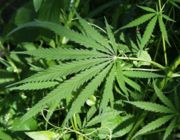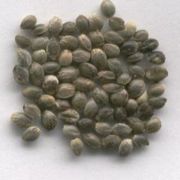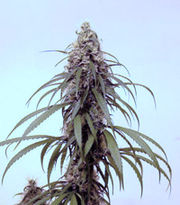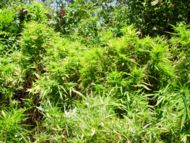| Cannabis | ||||||||||||
|---|---|---|---|---|---|---|---|---|---|---|---|---|
 |
||||||||||||
| Scientific classification | ||||||||||||
|
||||||||||||
| Cannabis sativa L |
Cannabis is a genus of flowering plant that includes one or more species. The plant is believed to have originated in the mountainous regions just north-west of the Himalayas. It is also known as hemp, although this term usually refers to varieties of Cannabis cultivated for non-drug use. Cannabis plants produce a group of chemicals called cannabinoids which produce mental and physical effects when consumed. As a drug it usually comes in the form of dried flowers and leaves (marijuana), resin (hashish), or various extracts collectively known as hash oil [1]. In the early 20th century, it became illegal in most of the world to cultivate or possess Cannabis for drug purposes.
Contents |
Species
Cannabis sativa L
Putative species or subspecies:
- C. indica Lam. = C. sativa L subsp. indica (Lam.) E. Small & Cronquist
- C. ruderalis Janisch. = C. sativa subsp. sativa var. spontanea Vav. = C. sativa L subsp. sativa
Description
Cannabis is a dioecious annual flowering herb. Cannabis usually has imperfect, unisexual flowers; the male (staminate) reproductive structures are completely separate from the female (carpellate, sometimes called pistillate) structures, [2] [3] although sometimes perfect hermaphrodite flowers also occur.[4] Cannabis is dioecious [2], which means that entire plants usually bear only male or only female flowers, with male flowers borne on loose panicles, and female flowers borne on racemes.[5] However it is not unusual for individual plants to bear both male and female flowers, a condition called monoecy. [6] Flowers of both sexes sometimes occur on separate inflorescences, or sometimes within the same inflorescence. [4] Dense clusters of female flowers produced by drug varieties of Cannabis are commonly called "buds" although in this usage the term refers to clusters of mature flowers, rather than the undeveloped shoots that the word ordinarily describes.
All varieties of Cannabis are wind-pollinated [2] [7] and produce seeds that are called nuts [2] or achenes. [8]. Most varieties of Cannabis are short day plants [7], with the exception of C. sativa subsp. sativa var. spontanea (syn. C. ruderalis), which is commonly described as "auto-flowering" and may be either day-neutral or require long days.
Cannabis is used as a food plant by the larvae of some Lepidoptera species including Ghost Moth and The Nutmeg.
Taxonomy

The genus Cannabis was formerly placed with nettles in the family Urticaceae or with mulberries in the family Moraceae, but is now considered along with hops (Humulus sp.) to belong to the family Cannabaceae.
All strains of Cannabis can interbreed, and produce fertile offspring, which means that all known Cannabis plants satisfy one criterion for a single species type called Cannabis sativa L.[9]. But whether the different strains of Cannabis actually do constitute a single species or multiple species has been a contentious issue for more than two centuries.[10][11] [12][13][14]
Early classifications
Cannabis was first classified by Carolus Linnaeus in 1753 as a genus comprising a single species, called Cannabis sativa, describing hemp, which was widely cultivated at the time. In 1785, famous French biologist Jean-Baptiste Lamarck described C. indica, a type of Cannabis from India having morphological distinctiveness from the C. sativa previously described, and in particular not suitable for use as hemp because of poor fiber quality, but having greater potential as an inebriant. Numerous additional species were proposed in the 19th century, but by the beginning of the 20th century, the single-species concept was widely accepted.[5][10], except within the Soviet Union, where Cannabis continued to be the subject of active taxonomic study.
20th Century
In 1924, Janischevsky described the low-intoxicant type of wild (ruderal) Cannabis found in central Russia as either a species or a variety, proposing C. ruderalis or C. sativa var. ruderalis as alternative names.[10] In 1929, Vavilov described wild populations of drug-type Cannabis as the variiety C. indica var kafiristanica, and recognized the wild populations previously described by Janischevsky as the variety C. sativa L subsp sativa var. spontanea Vav. [14][15][11] In 1940, Serebriakova and Sizov proposed a classification of Cannabis recognizing C. sativa L and C. indica Lam. as distinct species, describing "common hemp" and "Indian hemp" respectively. Within common hemp, they recognized cultivated and wild populatins as distinct subspecies, C. sativa var. culta and C. sativa var spontanea. They additionally recognized a total of 17 varieties within C. sativa, including 4 distinct groups within the cultivated subspecies, but did not describe variation within C. indica.[10]
In the late 1960's and 1970's, the question of scientific classification of Cannabis took on legal importance in North America. Laws prohibiting Cannabis in the United States and Canada specifically named products of Cannabis sativa L. as the prohibited substances. Several persons charged with violating these laws claimed that the material was in fact derived from C. indica or C. ruderalis, and was therefore not prohibited by the laws. Legal defenses on this basis were not often successful. [14]
In the early 1970's, botanists Richard E. Schultes and Loran Anderson conducted taxonomic studies of Cannabis, and concluded that sufficient evidence exists to support recognition of three species, C. sativa L, C. indica Lam., and C. ruderalis Janisch. [16][17] For Schultes, this was a reversal of his previous opinion that Cannabis is a monotypic genus. [10] According to their species descriptions, C. sativa is tall and laxly branched with relatively narrow leaflets, C. indica is shorter, conical in shape, and has relatively wide leaflets, and C. ruderalis is short, branchless, and grows wild in central Asia. This concept was embraced by Cannabis aficionados who commonly distinguish narrow-leafleted "sativa" drug strains from wide-leafleted "indica" drug strains.

In 1976, Ernest Small and Arthur Cronquist proposed a classification comprising a single species Cannabis sativa L, with two subspecies: C. sativa L subsp. sativa and C. sativa L subsp. indica (Lam). According to this concept, C. sativa subsp. sativa was selected for traits that enhance fiber or seed production and has low levels of the psychoactive delta-9-tetrahydrocannabinol (THC), whereas C. sativa subsp. indica was primarily selected for drug production and has relatively high levels of THC. Within these subspecies they described C. sativa L subsp. sativa var. spontanea (Vav.) as a wild or escaped type of low-intoxicant Cannabis, and described C. sativa L subsp. indica var. kafiristanica (Vav.) as a wild or escaped variety of the high-intoxicant type. [11]. This classification was based on several factors, including interfertility, chromosome uniformity, systematic chemotype analysis, and numerical analysis of diagnostic characters. [11] [18]. [19] Ernest Small was awarded the G. M. Cooley Prize by the American Association of Plant Taxonomists for his work involving Cannabis. [20]
Ongoing research
Molecular analytical techniques developed in the late twentieth century are being brought to bear on questions of scientific classification. This has resulted in many reclassifications based on evolutionary systematics. Scientific classification of Cannabis has been investigated using molecular biology and genetic techniques.
Several groups conducted genetic analyses of RAPD markers among drug and fiber cultivars. These analyses showed an extremely high degree of genetic polymorphism between and within populations, suggesting a very high degree of potential variation, even in heavily selected cultivars. [21] [22] [23] Long-time Cannabis researcher EPM de Meijer described these analyses as confirming the continuity of the gene pool throughout the studied accessions, and as further confirmation that the genus comprises a single species. [24]
In 2004, Karl W. Hillig, then a postgraduate student at Indiana University teamed with Cannabis expert[25] Paul Mahlberg to conduct a chemotaxomic analysis of Cannabis, using analytical chemistry of cannabinoid content to determine allele frequencies within studied populations. They concluded that observed chemotypes support recognition of C. sativa and C. indica as distinct species, but concluded that recognition of C. ruderalis was not supported but rather was consistent with classification of C. ruderalis as C. sativa var spontanea Vav. The authors categorized fiber/seed landraces and feral populations from Europe, central Asia, and Asia Minor in C. sativa., and categorized narrow-leaflet drug (NLD), wide-leaflet drug (WLD) cultivars, southern and eastern Asian hemp cultivars, and feral Himalayan populations as C. indica. [15] In 2005, Hillig published another paper based on the same research, with additional statistical analyses, and this time proposed a 3-species classification, recognizing C. sativa, C. indica, and C. ruderalis.[26] In his doctoral dissertation, published the same year, Hillig stated that principal components analysis failed to differentiate the putative species, but that canonical variates analysis resulted in a high degree of discrimination of the putative species and infraspecific taxa. Hillig stated that the patterns of variation support a two-species concept, but not recognition of C. ruderalis as a separate species from C. sativa. His conclusion was that taxonomic revision of Cannabis is warranted, but further research is needed to substantiate his proposed taxonomic treatment. [27]
As of 2006, the single-species concept of Cannabis continues to be widely accepted. [28] [29] [30] [31] [24] [32] [33]
Popular usage
Breeders, seed companies, and cultivators of drug type Cannabis often describe the ancestry or gross phenotypic characteristics of cultivars by categorizing them as pure indica, mostly indica, indica/sativa, mostly sativa, or pure sativa.[34]
In September of 2005, New Scientist reported that researchers at the Canberra Insitute of Technology had identified a new subspecies of Cannabis, based on analysis of mitochondrial and chloroplast DNA. [35]. The New Scientist story, which was picked up by many news agencies and web sites, indicated that the research was to be published in the journal Forensic Science International. As of November 2006, the work has not appeared in that journal.
Geographical distribution
Wild cannabis
Wild C. sativa subsp. indica is mainly confined to hash producing areas such as Afghanistan, and parts of Morocco. Wild C. sativa subsp. sativa shows great local variation; for example, in warm places, it can reach heights up to 20 feet (6 m) tall, but in colder climates it can be as short as 1 foot (30 cm) in height. Almost every single flower branch bears a seed. The wild C. sativa subsp. sativa has long, thin and airy buds and a Christmas tree shape structure. Wild C. sativa subsp. indica remains compact and bushy with thick buds for the most part, and is sometimes used by the locals for hashish production. Generally, there are far fewer seeds in wild C. sativa subsp. indica.
In many areas, wild or naturalized populations of Cannabis are considered invasive species, and are often targeted by government-sponsored eradication programs.
Reproduction
Breeding systems

Cannabis has been described as predominantly dioecious [2] [7] [36], although some monoecious varieties have also been described [37] Subdioecy (the occurrence of monoecious individuals and dioecious individuals within the same population) is widespread. [6] [38] [39] Many populations have been described as sexually labile. [40] [41] [23]
As a result of intensive selection in cultivation, Cannabis exhibits many sexual phenotypes, which can be described in terms of the ratio of female to male flowers occurring in the individual or typical in the cultivar[42]. Dioecious varieties are preferred for drug production, where the female plants are preferred. Dioecious varieties are also preferred for textile fiber production, whereas monecious varieties are preferred for pulp and paper production. It has been suggested that the presence of monoecy can be used to differentiate between licit crops of monoecious hemp and illicit dioecious drug crops. [6]
Mechanisms of sex determination
Cannabis has been described as having one of the most complicated mechanisms of sex determination among the dioecious plants.[42] Many models have been proposed to explain sex determination in Cannabis.
Based on studies of sex reversal in hemp, it was first reported in 1924 by K. Hirata that an XY sex-determination system is present.[40] At the time, the XY system was the only known system of sex determination. The X:A system was first described in Drosophila spp in 1925.[43] Soon thereafter, Schaffner disputed Hirata's interpretation,[44] and published results from his own studies of sex reversal in hemp, concluding that an X:A system was in use and that futhermore sex was strongly influenced by environmental conditions.[41]
Since then, many different types of sex determination system have been discovered, particularly in plants[36]. Dioecy is relatively uncommon in the plant kingdom, and a very low percentage of dioecious plant species have been determined to use the XY system. In most cases where the XY system is found it is believed to have evolved recently and independently.[45]
Since the 1920's, a number of sex determination models have been proposed for Cannabis. Ainsworth[36] describes sex determination in the genus as using "an X/autosome dosage-type."

The question of whether heteromorphic sex chromosomes are indeed present is most conveniently answered if such chromosomes were clearly visible in a karyotype. Cannabis was one of the first plant species to be karyotyped, however, this was in a period when karyotype preparation was primitive by modern standards. Heteromorphic sex chromosomes were reported to occur in staminate individuals of dioecious 'Kentucky' hemp, but were not found in pistillate individuals of the same variety. Dioecious 'Kentucky' hemp was assumed to use an XY mechanism. Heterosomes were not observed in analyzed individuals of monoecious 'Kentucky' hemp, nor in an unidentified German cultivar. These varieties were assumed to have sex chromosome composition XX. [37] But according to other researchers no modern karyotype of Cannabis had been published as of 1996.[46] Proponents of the XY system state that Y chromosome is slightly larger than the X, but difficult to differentiate cytologically. [47]
More recently, Sakamoto and various co-authors[48][49] have used RAPD to isolate several genetic marker sequences that they name Male-Associated DNA in Cannabis (MADC), and which they interpret as indirect evidence of a male chromosome. Several other research groups have reported identification of male-associated markers using RAPD and AFLP[50] [23] [24]. Ainsworth commented on these findings, stating that "It is not surprising that male-associated markers are relatively abundant. In dioecious plants where sex chromosomes have not been identified, markers for maleness indicate either the presence of sex chromosomes which have not been distinguished by cytological methods or that the marker is tightly linked to a gene involved in sex determination." [36]
Environmental sex determination is known to occur in a variety of species.[51] Many researchers have suggested that sex in Cannabis is determined or strongly influenced by environmental factors [41]. Ainsworth reviews that treatment with auxin and ethylene have feminizing effects, and that treatment with cytokinins and gibberellins have masculinizing effects.[36] It has been reported that sex can be reversed in Cannabis using chemical treatment.[52]
Aspects of cannabis production and use

- Medical cannabis discusses its use as a medication.
Cannabis (drug) discusses its use as a recreational drug.
Spiritual use of cannabis discusses sacramental and religious use.
Hemp discusses its uses as a source of housing, oil, food, fibers, and industrial materials.
Cannabis (drug) cultivation discusses aspects of cultivation for medicinal and recreational drug purposes
Legal issues of cannabis focuses on the law and enforcement aspects of growing, transporting, selling and using cannabis as a drug.
Health issues and the effects of cannabis discusses the pharmacology, physical, and mental effects of Cannabis when used as drug.
Etymology
The plant name cannabis is probably of Semitic origin, possibly Hebrew.
Hebrew קְנֵה בֹּשֶׂם qěnēh bośem > קַנַּבּוֹס qannabbôs > Greek κανναβις kannabis > Latin cannabis > English
However, the earlier Sumerian language used the word "kanubi", which means 'cane of two (sexes?)'. This is possibly the source for the Semitic usage.
The Biblical Hebrew term qěnēh bośem, literally "reed of balm", probably [53] refers to cannabis according to some etymologists [54], but is more commonly thought to be lemon grass, calamus , or even sweet cane, due to widespread translation issues. [55] The Hebrew Bible mentions it in Exodus 30:23 where God commands Moses to make a holy oil of myrrh, cinnamon, qěnēh bośem and cassia to anoint the Ark of the Covenant and the Tabernacle (and thus God's Temple in Jerusalem). Notably, this anointing oil is a special herbal formula that functions as a kind of polish and fragrance for the Ark and Tabernacle, and the Bible forbids its manufacture and use to anoint people (Exodus 30:31-33) with the exception of the Aaronic priesthood (Exodus 30:30)
Elsewhere, the Hebrew Bible simply uses "reed" qānēh as the name of a plant in four places whose context seems to mean "reed of balm" as a fragrant resin, Isaiah 43:24, Jeremiah 6:20, Ezekiel 27:19 and Song of Songs 4:14. The Hebrew name "reed of balm" comes from qěnēh (the noun construct form of qāneh) means a "reed" or "cane" and bośem means "balm" or "aromatic" resin. Hebrew may have adapted the name qannabbôs from "reed of balm" qěnēh bośem as a substitute for the ambiguous name "reed".
This Biblical Hebrew term is often mistranslated as "calamus", also called "lemon grass" (Cymbopogon citratus) or "sweet flag" (Acorus calamus), following an ancient misunderstanding in the Greek Septuagint translation. The Hebrew Bible was written across centuries well up to the 5th Century BCE. However, centuries later, by the time the Septuagint was written around the 2nd Century BCE, the archaic Hebrew word qěnēh bośem appears to have already abbreviated into the later Hebrew form qannabbôs, which is attested in Post Biblical Hebrew literature. Thus, the Septuagint did not recognize the Hebrew expression "reed of balm" and mistook it to refer to some unidentified plant. As a dynamic equivalent, the Septuagint rendered it as "calamus" (Greek kalamos), which indeed is a "balmy" (scented) reed. The calamus plant was known in Greek mythology and processed into an aphrodisiac.
Unambiguous Hebrew or Aramaic references to cannabis are rare and obscure. Syriac has qanpa (a loan from kannabis) and tanuma (see the Comprehensive Aramaic Lexicon.) but neither is found in the Peshitta, the Syriac Bible. Late Syriac Ahiqar texts include qanpa as "ropes of hemp" (tunbei de-qanpa). The Hebrew word qanbes, a loan word from kannabis, is used in the Mishnah as hemp [Kilaim 2:5; 5:8; 9:1,7; Negaim 11:2] in the sense of a constituent of clothing or other items.
The Scythian term cannabis probably derives from a Semitic origin as well. Sara Benetowa of the Institute of Anthropological Sciences in Warsaw is quoted in the Book of Grass as saying:
The astonishing resemblance between the Semitic kanbos and the Scythian cannabis lead me to suppose that the Scythian word was of Semitic origin. These etymological discussions run parallel to arguments drawn from history. The Iranian Scythians were probably related to the Medes, who were neighbors of the Semites and could easily have assimilated the word for hemp. The Semites could also have spread the word during their migrations through Asia Minor.
Likely, the name 'cannabis' was known from the Semitic merchants who sold this commodity throughout the ancient trade routes of Southeast Asia.
Comparing the English word hemp and the Greek word kannabis shows that the word came down from the presumed Proto-Indo-European language. Words like kanapish for "hemp" occur in some Finno-Ugrian languages. It is likely that, soon after agriculture started, hemp as a cultivated plant spread widely, carrying its name with it. Source of Rus. konoplja, Pers. kanab, Lith. kanapes "hemp," and Eng. canvas and hemp.
References
- ^ Cannabis Basics
- ^ a b c d e Watson, L.; and Dallwitz, M.J. (1992 onwards). The families of flowering plants: descriptions, illustrations, identification, and information retrieval.
- ^ Lebel-Hardenack, Grant (1997). "Genetics of sex determination in flowering plants". Trends in Plant Science 2 (4): 130–136.
- ^ a b V. M. Cristiana Moliterni, Luigi Cattivelli, P. Ranalli and Giuseppe Mandolino (2005). "The sexual differentiation of Cannabis sativa L.: A morphological and molecular study". Euphytica 140 (1-2): 95-106.
- ^ a b Bouquet, R. J.. CANNABIS. United Nations Office on Drugs and Crime.
- ^ a b c Mignoni, G (1999). Cannabis as a licit crop: recent developments in Europe. United Nations Office on Drugs and Crime. Retrieved on 2006-10-05.
- ^ a b c Clarke, Robert Connell (December 1991). Marijuana Botany, 2nd ed., Ronin Publishing. ISBN 091417178X.
- ^ Fleming, M. P., R. C. Clarke (1998). "Physical evidence for the antiquity of Cannabis sativa L. (Cannabaceae)". Journal of the International Hemp Association 5 (2).
- ^ Greg Green. 2005. The Cannabis Breeder’s Bible. Green Candy Press 14
- ^ a b c d e Small, Ernest (1975). American law and the species problem in Cannabis: Science and semantics.
- ^ a b c d Small, E., A. Cronquist (1976). "A practical and natural taxonomy for Cannabis". Taxon 25 (4): 405–435.
- ^ Emboden, W. A. 1981. The genus Cannabis and the correct use of taxonomic categories. J. Psychoactive Drugs 13: 15–21.
- ^ Schultes, R. E., and A. Hofmann. 1980. Botany and Chemistry of Hallucinogens. C. C. Thomas, Springfield, IL., pp. 82–116.
- ^ a b c Ernest Small (1975). "On Toadstool Soup and Legal Species of Marihuana". Plant Science Bulletin 21 (3). Retrieved on 2006-10-24.
- ^ a b Hillig, Karl W., Paul G. Mahlberg (2004). "A chemotaxonomic analysis of cannabinoid variation in Cannabis (Cannabaceae)". American Journal of Botany. 91: 966-975.
- ^ Schultes, R. E., et. al. 1974. Cannabis: an example of taxonomic neglect. Harvard University Botanical Museum Leaflets 23: 337–367.
- ^ Anderson, L. C. 1974. A study of systematic wood anatomy in Cannabis. Harvard University Botanical Museum Leaflets 24: 29–36.
- ^ Small, Ernest (1976). "A Numerical Taxonomic Analysis of Cannabis with Special Reference to Species Delimitation". Systematic Botany 1 (1): pp. 67-84.
- ^ Small, E., H. D. Beckstead (1973). "Common cannabinoid phenotypes in 350 stocks of Cannabis". Lloydia 36: 144–165.
- ^ Ernest Small (biography). National Research Council Canada. Retrieved on 2006-10-28.
- ^ Faeti, V., G. Mandolino and P. Ranalli (1996). "Genetic diversity of Cannabis sativa germplasm based on RAPD markers". Plant Breeding 115: 367–370.
- ^ Forapani, S., A. Carboni, C. Paoletti, V. M. C. Moliterni, and P. Ranalli et al. (2001). "Comparison of hemp (Cannabis sativa L.) varieties using RAPD markers". Crop Science 41: 1682-1689. Retrieved on 2006-10-26.
- ^ a b c Mandolino, Giuseppe, Paolo Ranalli (2002). "The Applications of Molecular Markers in Genetics and Breeding of Hemp". Journal of Industrial Hemp 7 (1).
- ^ a b c Etienne P. M. de Meijer, Manuela Bagatta, Andrea Carboni, Paola Crucitti, V. M. Cristiana Moliterni, Paolo Ranalli, and Giuseppe Mandolino (2003). "The Inheritance of Chemical Phenotype in Cannabis sativa L.". Genetics 163 (1): 335-346. Retrieved on 2005-10-24.
- ^ Dr. Paul G. Mahlberg's Cannabis Research. North American Industrial Hemp Council. Retrieved on 2006-10-26.
- ^ Hillig, K.W. 2005. Genetic evidence for speciation in Cannabis (Cannabaceae). Genetic Resources and Crop Evolution 52: 161-180.
- ^ Hillig, Karl William, PhD (2005). "A systematic investigation of Cannabis". Indiana University. Retrieved on 2006-10-12.
- ^ Germplasm Resources Information Network - (GRIN). USDA, ARS, National Genetic Resources Program. Retrieved on 2006-10-24.
- ^ Multilingual Multiscript Plant Name Database. The University of Melbourne (1995 - 2004). Retrieved on 2006-10-24.
- ^ Integrated Taxonomic Information System (ITIS). Retrieved on 2006-10-24.
- ^ USDA, NRCS (2006). The PLANTS Database. National Plant Data Center. Retrieved on 2006-11-01.
- ^ Clarke, RC, DP Watson (2002). Grotenhermen and Russo (eds.) Cannabis and Cannabinoids: Pharmacology, Toxicology,and Therapeutic Potential. Binghamton, NY: The Haworth Integrative Healing Press, 10. ISBN 0-7890-1507-2.
- ^ Watts G (2006). "Cannabis confusions". BMJ 332 (7534): 175-6.
- ^ Greg Green. 2005. The Cannabis Breeder’s Bible. Green Candy Press 14
- ^ Rasta lends its name to a third type of cannabis. New Scientist (2005-09-20). Retrieved on 2006-11-05.
- ^ a b c d e Ainsworth, Charles (2000). "Boys and Girls Come Out to Play: The Molecular Biology of Dioecious Plants". Annals of Botany 86: 211-221.
- ^ a b Menzel, Margaret Y (1964). "Meiotic Chromosomes of Monoecious Kentucky Hemp (Cannabis sativa)". Bulletin of the Torrey Botanical Club 91 (3): 193-205.
- ^ Schumann, E, Peil A, Weber WE (1999). "Preliminary results of a German field trial with different hemp (Cannabis sativa L.) accessions". Genetic Resources and Crop Evolution 46 (4): 399-407.
- ^ Ranalli, Paolo (2004). "Current status and future scenarios of hemp breeding". Euphytica 140 (1): 121-131.
- ^ a b Hirata, K (1924). "Sex reversal in hemp". Journal of the Society of Agriculture and Forestry 16: 145-168.
- ^ a b c Schaffner, JH (1931). "The Fluctuation Curve of Sex Reversal in Staminate Hemp Plants Induced by Photoperiodicity". American Journal of Botany 18 (6): 424-430.
- ^ a b Truta, E, Gille E, Toth E, Maniu M (2002). "Biochemical differences in Cannabis sativa L. depending on sexual phenotype". Journal of Applied Genetics 43 (4): 451-462. Retrieved on 2006-09-03.
- ^ Bridges, CB (1925). "Sex in relation to chromosomes and genes". American Naturalist 59: 127-137.
- ^ Schaffner, JH (1929). "Heredity and Sex". The Ohio Journal of Science 29 (1): 289-300.
- ^ Negrutiu, Vyskot B, Barbacar N, Georgiev S, Moneger F (2001). "Dioecious plants. A key to the early events of sex chromosome evolution". Plant Physiology 127 (4): 418-24.
- ^ Hong, Shao, Robert C. Clarke. "Taxonomic studies of Cannabis in China". Journal of the International Hemp Association 3 (2): 55-60.
- ^ Peil, A., H. Flachowsky, E. Schumann, W. E. Weber (2003). ""Sex-linked AFLP markers indicate a pseudoautosomal region in hemp (Cannabis sativa L.)". Theoretical and Applied Genetics 107: 102-109.
- ^ Sakamoto, K, Shimomura K, Komeda Y, Kamada H, Satoh S (1995 Dec). "A male-associated DNA sequence in a dioecious plant, Cannabis sativa L.". Plant & Cell Physiology 36 (8): 1959-54.
- ^ Sakamoto, K, Abe T, Matsuyama T, Yoshida S, Ohmido N, Fukui K, Satoh S (2005). "RAPD markers encoding retrotransposable elements are linked to the male sex in Cannabis sativa L". Genome 48 (5): 931-936.
- ^ Törjék, O, Bucherna N., Kiss E., Homoki H., Finta-Korpelová Z., Bócsa I., Nagy I., Heszky L.E. (2002). "Novel male specific molecular markers (MADC5, MADC6) for sex identification in hemp". Euphytica 127: 209-218.
- ^ Tanurdzic, M, Banks JA (2004). "Sex-determining mechanisms in land plants". Plant Cell 16 (Suppl): S61-71.
- ^ Mohan Ram, H.Y, R. Sett (1982). "Induction of fertile male flowers in genetically female Cannabis sativa plants by silver nitrate and silver thiosulfate anionic complex". Theor. Appl. Genet. 62: 369–375.
- ^ Weston La Barre. 1980. Hebrew University. Israel
- ^ Sula Benet. 1936. Institute of Anthropological Sciences. Warsaw
- ^ Immanuel Löw. 1925. Flora der Juden. 1924-1934, reprinted 1967
Further reading
- Cannabis: A History (2005) Martin Booth ISBN 0-312-32220-8
- UNODC: World Drug Report 2006, Chapter 2: Cannabis: Why We Should Care (2006)
External links
- International Plant Names Index (IPNI)
- The Endocannabinoid System Network (ECSN) - Contains medical information to the Endocannabinoid System




 216.73.216.81
216.73.216.81 User Stats:
User Stats:
 Today: 0
Today: 0 Yesterday: 0
Yesterday: 0 This Month: 0
This Month: 0 This Year: 0
This Year: 0 Total Users: 117
Total Users: 117 New Members:
New Members:
 216.73.xxx.xx
216.73.xxx.xx
 Server Time:
Server Time: